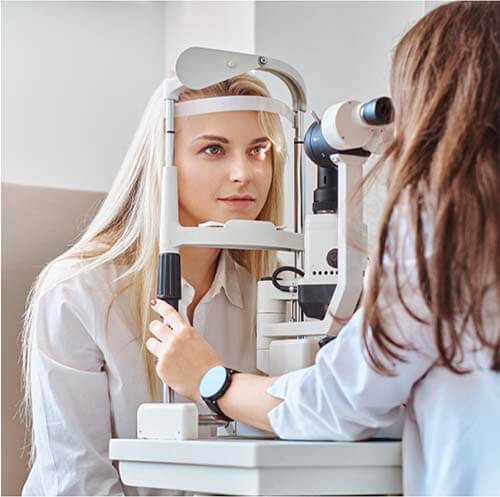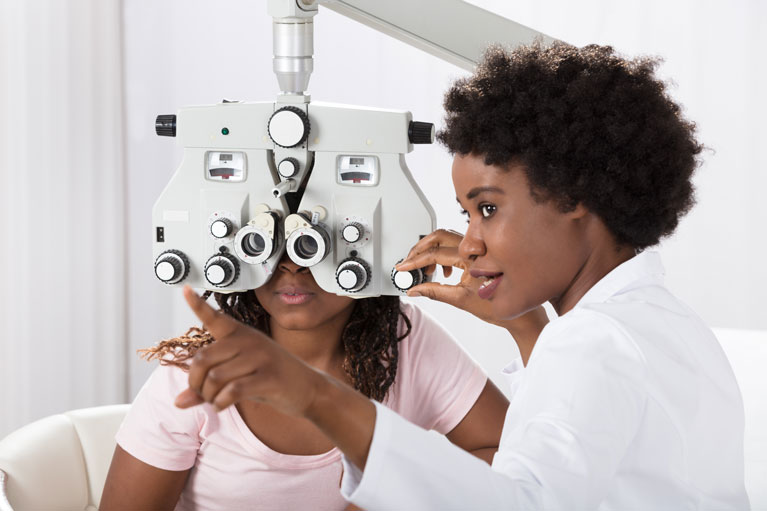The Comprehensive Eye Exam: What to Anticipate Throughout Your Visit to the Eye Doctor
A see to the eye medical professional for an extensive eye examination is greater than a routine examination; it is a vital action in guarding your visual health. From the initial discussion of your case history to the accuracy of the aesthetic skill test, each part of the exam offers a details purpose. But exactly what happens throughout the eye wellness evaluation, and how does it influence the prescription procedure? Comprehending these elements is necessary for those that want to maintain optimum sight. As we check out each element, the importance of follow-up suggestions will additionally come to be clear.
Initial Assessment
The first assessment throughout an eye exam offers as an essential foundation for understanding a person's visual wellness needs. This phase sets the tone for the entire assessment procedure, allowing the eye doctor to collect vital information concerning the patient's case history, way of living, and specific vision worries. By thoroughly evaluating any kind of pre-existing problems, medications, or previous surgical procedures, the eye care expert can customize the examination to deal with private needs effectively.

Furthermore, the first consultation is an opportunity for patients to articulate any problems or inquiries, cultivating a joint connection with their health care supplier. This communication not only guarantees that the client feels educated and comfy however also empowers them to participate proactively in their eye health and wellness administration. Collectively, these conversations make it possible for the eye doctor to develop a customized evaluation strategy, making certain ideal care and specific diagnosis.
Visual Skill Test
Starting the core elements of an eye exam, the visual skill test is made to evaluate the intensity and clarity of a person's vision. This important assessment aids identify just how well a person can determine letters or symbols at a standard range, normally utilizing a Snellen chart (Eye Doctor Optometrist). The chart consists of rows of letters that reduce in dimension inside out, with the client placed at a normal distance of 20 feet
During the examination, the person is asked to cover one eye and read aloud the smallest line of letters they can see plainly. This procedure is repeated for the other eye. The results are videotaped as a fraction, with 20/20 vision indicating normal aesthetic skill-- where the patient can see at 20 feet what a person with typical vision can see at that range.
The aesthetic skill examination also identifies prospective refractive errors such as astigmatism, hyperopia, or nearsightedness, which could necessitate corrective lenses. By establishing a baseline of visual performance, the test is an essential diagnostic tool that helps the eye care expert in establishing an ideal therapy strategy customized to the person's unique visual needs.
Eye Health Assessment
Following the visual acuity examination, an extensive eye health assessment is conducted to guarantee the general well-being of the eyes. This important section of the eye examination entails a complete examination of both the exterior and inner structures of the eye. The ophthalmologist or optometrist begins by analyzing the eyelids, cornea, conjunctiva, and sclera for any type of indications of infection, inflammation, or irregularities. Using specialized tools like a slit lamp, the professional gains an amplified sight of the eye's composition, allowing detailed examination.
Next, interest shifts to the interior frameworks. With the use of ophthalmoscopy or fundus photography, the retina, optic nerve, and blood vessels are thoroughly assessed. This action is important for identifying problems such as retinal detachment, glaucoma, or diabetic retinopathy. Oftentimes, pupil dilation is executed to enhance presence of the interior eye frameworks, although this may lead to short-lived light sensitivity for the individual.
Furthermore, intraocular stress is gauged to screen for glaucoma danger. This is normally done using tonometry, which can detect elevated pressure degrees that may recommend potential damage to the optic nerve. Collectively, these assessments form a detailed evaluation to read the article keep eye wellness.
Refraction and Prescription
Refraction is a sophisticated treatment performed by eye care professionals to determine the specific lens power required to remedy refractive mistakes such as myopia, presbyopia, hyperopia, and astigmatism. The goal of this treatment is to examine exactly how light bends as it passes through the eye, permitting the professional to identify whether rehabilitative lenses are needed for improved aesthetic acuity.
Throughout the refraction process, the patient is asked to look with a phoropter, a device that has various lenses. The specialist will systematically alter these lenses and ask the client to compare clarity in between options up until the best feasible vision is achieved. This treatment is crucial in crafting an exact prescription that specifies the ideal lens power for eyeglasses or call lenses.
The prescription originated from this treatment not just optimizes vision yet also functions as a structure for selecting appropriate rehabilitative eyewear. It is necessary to guarantee that prescriptions are routinely upgraded, as changes in vision can happen over time, stressing the significance of regular eye examinations. This careful interest to information assists preserve clear, comfy vision in life.
Follow-Up Suggestions

During a follow-up visit, the eye doctor will conduct a series of tests to examine visual acuity and look for any adjustments in vision that might necessitate an update to the prescription. Additionally, the follow-up gives an opportunity to review any type of pain or problems experienced with existing eyewear. Modifications can be made to ensure comfort and efficacy, whether via lens alteration or frame modifications.
For patients with continuous conditions such as glaucoma, diabetes-related eye problems, or macular deterioration, even more constant follow-ups might be necessary. These consultations are important for managing and potentially reducing the development of eye condition. Complying with these recommendations can significantly add to preserving visual health and stopping lasting difficulties.
Verdict
The thorough eye test is a necessary process for maintaining visual health and wellness, incorporating an in-depth assessment of medical background and vision worries. Trick components include the visual acuity examination, which reviews eyesight clarity, and the eye health and wellness assessment, which takes a look at the additional info overall condition of the you can find out more eyes. Refraction tests aid figure out the precise lens prescription required for optimal vision improvement. Follow-up referrals provide support for recurring eye treatment, making sure that any type of prospective issues are attended to without delay and successfully.
A check out to the eye medical professional for an extensive eye exam is more than a regular exam; it is a crucial step in guarding your visual wellness.Kicking off the core elements of an eye examination, the visual skill examination is developed to analyze the sharpness and clearness of a client's vision.Adhering to the aesthetic skill test, a detailed eye wellness assessment is conducted to make sure the general well-being of the eyes. These check outs allow the eye care professional to keep track of changes in vision, upgrade prescriptions, and analyze the total health and wellness of the eyes. Trick components consist of the aesthetic acuity test, which reviews sight clearness, and the eye wellness evaluation, which takes a look at the overall condition of the eyes.